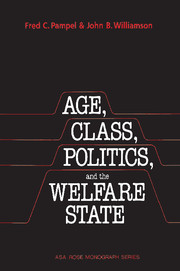Book contents
- Frontmatter
- Contents
- List of tables
- Preface
- 1 The welfare state: some neglected considerations
- 2 Theoretical perspectives on the welfare state
- 3 Social welfare spending in advanced industrial democracies
- 4 Social welfare spending and democratic political context
- 5 Economic growth, social welfare spending, and income inequality
- 6 Infant mortality, equality, and social welfare spending
- 7 Conclusions: The causes and consequences of the welfare state
- References
- Index
- Other books in the series
6 - Infant mortality, equality, and social welfare spending
Published online by Cambridge University Press: 30 April 2010
- Frontmatter
- Contents
- List of tables
- Preface
- 1 The welfare state: some neglected considerations
- 2 Theoretical perspectives on the welfare state
- 3 Social welfare spending in advanced industrial democracies
- 4 Social welfare spending and democratic political context
- 5 Economic growth, social welfare spending, and income inequality
- 6 Infant mortality, equality, and social welfare spending
- 7 Conclusions: The causes and consequences of the welfare state
- References
- Index
- Other books in the series
Summary
The concern of sociologists with income inequality perhaps has overshadowed an equally important component of equality: the provision of basic physical needs of the population and its poor. As much for its own sake, the value of an egalitarian income distribution may come from the ability it gives the poor to improve their physical well-being and quality of life. The way in which income distribution translates into the day-to-day life of a population reflects the dispersion of social rewards and deserves study in its own right.
Although there are many ways to study physical needs, well-being, or the quality of life (Morris, 1979; Estes, 1984), we concentrate on one commonly used indicator – the infant mortality rate. The survival of infants depends strongly on the physical environment in which a child comes to term and is born. It closely reflects nutrition, sanitation, medical care, financial resources, education of the parents, and other aspects of physical well-being. Further, infant mortality is highly responsive to socioeconomic conditions and is more highly concentrated among the poor (Anderson, 1973; Gortmaker, 1979). Indeed, in an important sense, the decline of infant mortality reflects the diffusion of an acceptable standard of living from the elite to the masses and the poor. Because a biological limit appears to exist on how low infant mortality can go, the benefits of a declining rate must eventually extend to the poor.
- Type
- Chapter
- Information
- Age, Class, Politics, and the Welfare State , pp. 138 - 164Publisher: Cambridge University PressPrint publication year: 1989



